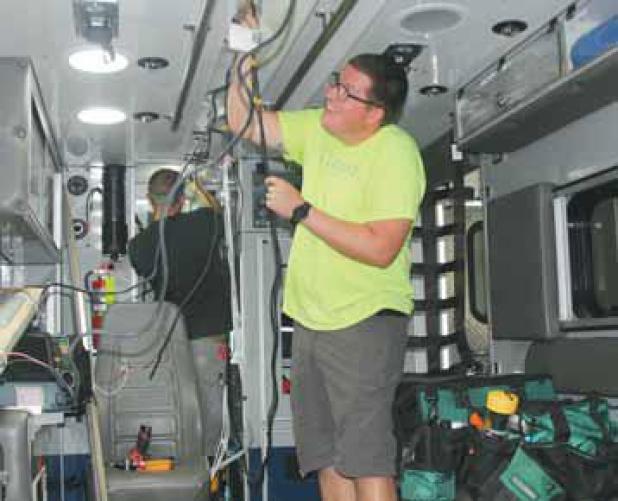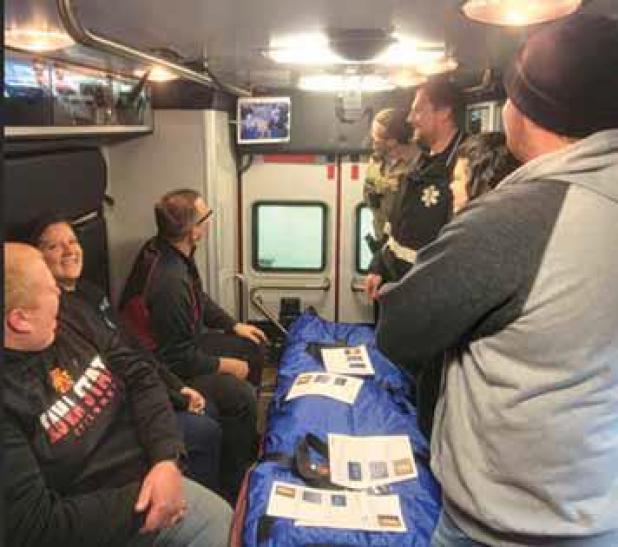
Last week, a Marshall County ambulance was equipped with a tablet, microphones, speakers, and cellular boosters that will allow the EMTs to connect to board-certified physicians and nurses through a telemedicine program. Britton native Robb Price, owner of the company GREVO, and his partner Daniel Price were on hand to install the equipment.

The Avel eCare system is tested after a recent install in another SD ambulance. Over 100 ambulances will receive the system.
Telemedicine In Motion
In recent years, telehealth has exponentially risen in popularity. Patients can now easily visit with providers virtually even though the physician may be half a world away. Now, thanks to state initiatives, similar technology is being employed for emergency responders across South Dakota. Most recently, this includes Marshall County Ambulance.
Last week, technicians were in Britton to install the Avel eCare EMS system in one of the Marshall County ambulances. Britton native Robb Price, owner of GREVO, a company that installs products in emergency vehicles, was one of the technicians on hand for the project.
Price explained that the project involves equipping the ambulance with a cabinmounted telehealth tablet, microphones, and speakers. In addition, antennas and cellular boosters are installed to support strong connectivity in the field.
“There are actually 13 antennas installed with this system,” Price said. “That allows it to switch between cell providers no matter where you are.” All of this technology has been designed to augment the services and actions of EMTs.
So what is this fancy system used for in an ambulance that might be bumping over gravel roads? The goal of all that technology is to support EMS personnel by lending a virtual hand when they need it. When responding to a call, the EMS crew can call Avel eCare Emergency and, within moments, a board-certified ER doctor, a team of nurses and a paramedic will show up on the screen to assist. Avel’s team of expert providers, nurses, and clinicians are all trained in telemedicine.
Price explains that the experts located in Sioux Falls can see the patient and EMTs via a camera, hear them thanks to a microphone and talk to them through the speakers. “It’s like having an extra hand on your shoulder helping you out,” he added. The support is available 24/7 as well.
Regarding what the virtual providers can help with, it’s a long list. The Avel eCare system can support EMS agencies with triage, airway and ventilation, trauma care, medication decisions, circulation, hemorrhage, or other cardiovascular needs. They can also help communicate with the receiving hospital and emergency room so vitals and tests are relayed in an efficient manner.
MarshallCountyParamedic and Emergency Management Director Logan Roehr said he is happy to see this tool as it will help offer guidance and an extra security blanket when they respond to calls.
Roehr also said the system will provide support in a critical time for rural ambulance services, including Marshall County. He points out that they are seeing, as is much of the state, declining volunteerism and dwindling participation in volunteer crews.
“Avel eCare will be able to act as additional ‘hands’ when we don’t have them,” said Roehr. “When we don’t have that option of an extra person, this system can be that.”
The Avel system is a statefunded program. Gov. Kristi Noem and state lawmakers approved three initiatives in 2022 that infused up to $20 million into EMS across the state. “Telemedicine in Motion” is the first of the initiatives, at a cost of $1.7 million. The program includes free installation, training, software and hardware, as well as support and a telehealth subscription for professional consulting services.
Price and his team have been busy with the installation of the Avel eCare systems across the state. He explained that they have installed around 80 already since just last year and were in both Eureka and Frederick the same day they installed the Marshall County system.
A long-time first responder himself, Price added that in rural areas where the call volume may be comparatively low, sometimes having backup is comforting. “It takes a long time to get comfortable with critical patients,” he emphasized. “So having this extra support can be very reassuring to EMTs.”
Other state initiatives include upgrades to EMS agencies’ LIFEPAK-15 patient monitors/defibrillators. All of the ambulances in Marshall County were recently fitted with the updated machines. “The LIFEPAK allows us to send what we’re seeing on the machine to the telehealth providers and the receiving hospital,” said Roehr.
At the end of the day, EMTs will always face highstress, challenging situations. But with the extra help that the newly installed systems are capable of, Roehr said he feels confident in the level of care Marshall County can continue to provide.
“We want to give the best we can to the people we serve,” said Roehr. “This new technology will help with that.”
Roehr added that Marshall County Ambulance Service is always looking for volunteers. If you would be interested in completing an EMT course, contact him at logan.roehr@marshall.co.sd.us. If you are already certified, reach out to any member of Marshall County Ambulance for details on how to join.
